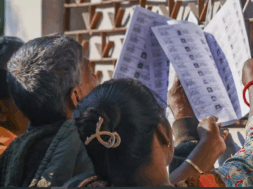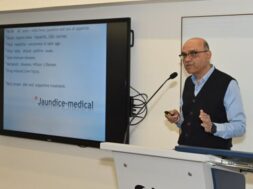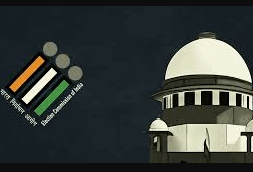
Supreme Court Upheld UP Madrasa Act but Rejects Rules Regulating Higher Education
Manas Dasgupta
NEW DELHI, Nov 5: The Supreme Court on Tuesday upheld the constitutional validity of the Uttar Pradesh Madrasa Act of 2004 and clarified that the madrasas running in the state could continue to operate but declared as unconstitutional its provisions for regulating higher education to be in conflict with the University Grants Commission Act.
Partially upholding the Uttar Pradesh Board of Madrasa Education Act, 2004, the apex court rejected the Allahabad High Court judgement of April, 2024, while confirming that the State can regulate madrasa education to ensure standards of excellence.
A three-judge Bench headed by Chief Justice of India D.Y. Chandrachud on Tuesday pronounced its verdict on pleas challenging the Allahabad High Court judgment that had declared the Madrasa Act as unconstitutional and held the law as “constitutional” and clarified that the madrasas running under the said Act would continue to operate.
But while upholding that the law secured the interests of the Muslim minority community in Uttar Pradesh, the Supreme Court held that the Madrasa Act to the extent it regulates higher education at the levels of Fazil (under-graduate studies) and Kamil (post-graduate studies) were in direct conflict with the provisions of the University Grants Commission (UGC) Act, and thus, unconstitutional.
The Allahabad High Court had on March 22 struck down the Uttar Pradesh Madrasa Education Board Act, 2004 saying the law was unconstitutional for validating a system of education which was grossly in violation of the principles of secularism. But the Supreme Court on April 5 had stayed the operation of the Allahabad High Court judgement.
The Uttar Pradesh law had wandered into the Centre’s exclusive domain under Entry 66 of the Union List in the Seventh Schedule of the Constitution. Entry 66 conferred the Union the authority to make laws to determine and regulate the standards of higher education.
The judgment, authored by the Chief Justice, said the 2004 Act, except at the Fazil and Kamil levels, was “consistent with the positive obligation of the State to ensure that students studying in recognised madrasas attain a minimum level of competency that allows them to effectively participate in society and earn a living.”
Chief Justice Chandrachud observed that the 2004 Act, which allowed the Board to prescribe the academic curriculum, textbooks, qualification of teachers and standards of equipment and infrastructure, did not directly interfere with the day-to-day administration of recognised madrasas.
The court, while noting that minorities had a right under Article 30 of the Constitution to establish and administer madrasas to impart religious or secular education, said the right was “not absolute.” “The State has an interest in maintaining the standards of education in minority institutions and may impose regulational conditions for grant of aid and recognition. The Constitutional scheme allows the State to strike a balance between ensuring the standard of excellence and preserving the right of the minorities to establish and administer its educational institutions,” the court explained.
The unanimous judgment, with Justices J.B. Pardiwala and Manoj Misra on the Bench, said ‘education’ in Entry 25 of the Concurrent List must be given a wide meaning. Though recognised madrasas imparted religious instruction, their primary aim was education, bringing them within the ambit of Entry 25. The Board under the Act conducted exams and conferred certificates to students.
The top court set aside an Allahabad High Court judgment that the 2004 Act breached Article 21A (right to education) of the Constitution and violated the Basic Structure principle of secularism enshrined in the Preamble.
Chief Justice Chandrachud explained that Article 21A must be read consistently with the rights of religious and linguistic minorities to establish and administer educational institutions of their choice. The Madrasa Board under the Act, with the approval of the State government, was free to enact regulations “to ensure that religious minority institutions impart secular education of a requisite standard without destroying the minority character”.
“The mere fact that the education sought to be regulated includes some religious teaching or instruction does not push a legislation outside the legislative competence of a State,” the court noted. However, the CJI referred to Article 28(3) of the Constitution to add that a student attending a minority institution recognised by the State or receiving aid out of public funds should not be compelled to take part in religious instruction or forced to attend religious worship.
On the High Court’s take that the Madrasa Act violated secularism, Chief Justice reasoned that the infraction by the law should be traced to an express provision of the Constitution, and cannot be quashed by making a blanket statement that it contravened the Basic Structure.
“The constitutional validity of a statute cannot be challenged for the violation of the Basic Structure of the Constitution… In a challenge to the validity of a statute for violation of secularism, it must be shown that the law violates the provisions of the Constitution pertaining to secularism… The High Court erred in holding that the statute is bound to be struck down if it is violative of the Basic Structure,” the CJI held.
The State claimed to have fought tooth and nail for the survival of the Uttar Pradesh Board of Madrasa Education Act, 2004 in the High Court. However, it later said it was reconciled to the High Court’s point of view that the Act threatened the principles of secularism and was violative of the Basic Structure of the Constitution.
Additional Solicitor General K.M. Nataraj, for Uttar Pradesh, had told the Supreme Court earlier that the course of instruction provided in madrasas did not involve broad-based subjects such as Maths, Science, Social Studies. “Study of secular subjects was optional,” Mr Nataraj pointed out. But the court countered the State’s logic, asking how the striking down of a law regulating madrasas would ensure that madrasa students were instructed in Maths, Science, Social Studies, languages and History.
“The remedy would not be to strike down the Madrasa Board Act, but to issue suitable directions to enable students pursuing their education in madrasas to access the quality of education made available by the State in other institutions,” Chief Justice Chandrachud dictated in the order for the Bench.
The apex court held that the act was consistent with the positive obligation of the State to ensure that the students studying in the recognised madrasas attain a level of competency which will allow them to actively participate in society and earn a living.
It said the Article 21A and the Right to Education Act have to be read consistently with the right of religious and linguistic minorities to establish and administer educational institutions of their choice. The Board with the approval of the state government can enact regulations to ensure that religious minority educations impart secular education of requisite standards without destroying their minority character.
It said the Allahabad High Court erred in holding that the UP madrasa law had to be struck down for violating basic structure i.e. the principle of secularism.
On October 22, a bench comprising CJI DY Chandrachud and Justices JB Pardiwala and Manoj Misra had reserved the judgement on eight petitions, including the lead one filed by Anjum Kadari, against the Allahabad High Court verdict.
Earlier, on March 22, the Allahabad High Court had declared the Act as “unconstitutional” and violative of the principle of secularism and asked the state government to accommodate madrasa students in the formal schooling system.
On April 5, the CJI-led bench had provided a breather to about 17 lakh madrasa students by staying the verdict of the Allahabad High Court scrapping the Uttar Pradesh Board of Madrasa Education Act, 2004. During the hearing, the CJI had observed that secularism means to “live and let live.”














